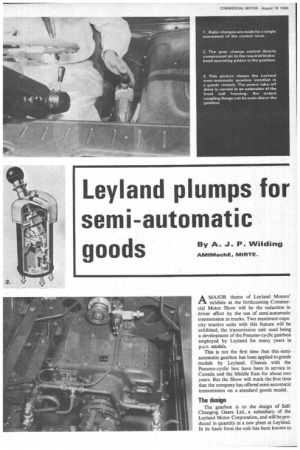Leyland plumps for semi-automatic goods
Page 50

Page 51

If you've noticed an error in this article please click here to report it so we can fix it.
By A. J. P. Wilding
AMIMechE, MIRTE.
AMAJOR theme of Leyland Motors' exhibits at the forthcoming Commercial Motor Show will be the reduction in driver effort by the use of semi-automatic transmission in trucks. Two maximum capacity tractive units with this feature will be exhibited, the transmission unit used being a development of the Pneumo-cyclic gearbox employed by Leyland for many years in p.s.v. models.
This is not the first time that this semiautomatic gearbox has been applied to goods models by Leyland. Chassis with the Pneumo-cyclic box have been in service in Canada and the Middle East for about two years. But the Show will mark the first time that the company has offered semi-automatic transmission on a standard goods model.
The design
The gearbox is to the design of SelfChanging Gears Ltd., a subsidiary of the Leyland Motor Corporation, and will be produced in quantity in a new plant at Leyland. In its basic form the unit has been known to the passenger side of the industry for many years. It consists of a series of epicyclic gear trains 'and reduction ratios are obtained by holding particular annular gears stationary through brake bands. Direct drive is obtained through a multi-plate clutch at the front of the box which locks all the epicyclic gearing together so that it rotates as a single mass.
Forward ratios in the five-speed unit used by Leyland are 7,25, 4.28, 2.43, 1.59 and 1 to 1 whilst reverse is 7.25 to 1: Selection and engagement of each gear is accomplished by the single operation of moving a short lever in the gate of a compact gear-change control unit. This sends an air-pressure signal to the gearbox to feed compressed air into the operating cylinder of the brake band for the appropriate ratio; there are individual cylinders for each ratio and the brake bands are automatically adjusted for wear.
Power is transmitted from the engine to the gearbox through a fluid clutch which is, in effect, a combination in one unit of a fluid coupling and a centrifugal lock-up clutch. The fluid coupling deals with the requirements of smooth take-up from rest whilst the centrifugal clutch ensures that there is positive drive between the engine and gearbox above a certain engine speed. This has the effect of improving fuel economy and a second advantage is that the full retarding effect of the engine can be employed on overrun.
Alteration in technique One of the factors that has made this particular design of semi-automatic gearbox practicable for goods vehicles running at up to 32 tons gross is that it has been found possible to use it in conjunction with a two-speed rear axle; Leyland considers five forward ratios inadequate for these classes of vehicle. An alteration in the technique used in making axle-ratio changes is necessary as the drive is always engaged, but it is reported that drivers have had no difficulty in adapting themselves to the different method. Both the Leyland Show models with semi-automatic transmission will have 4.87/6.63 to 1 rear axle ratios. With the layout the driver has, in effec ten evenly-spaced forward ratios. The axk ratio change is effected by a switch at th control knob.
Specification of semi-automatic transmii sion does not increase chassis weight, am the cost should be recovered in savings a maintenance and better vehicle utilization Standards of driving are often not as high a is desirable and this generally shows up ii increased costs through gearbox and elute] troubles. A driver cannot misuse a semi automatic transmission so there must be ; reduction in maintenance costs. There wil also be advantages in other directions. Fo example, the facility of making quick am easy ratio changes will eliminate any ten dency to overwork the engine on hills rathe than make a difficult change; there is alst added safety as the driver will be able tt concentrate more on driving. Other impor tant points about 'the Leyland design are tha the gearbox can be mounted as a unit witi the engine or independently and that a powei take-off connection can be provided.




































































































































